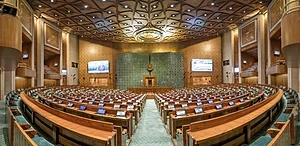In a significant move, the Indian government introduced two key bills in the Lok Sabha aimed at holding simultaneous elections across the country. The Constitution (One Hundred and Twenty-Ninth Amendment) Bill and the Union Territories Laws (Amendment Bill) were introduced as part of the government’s push for what it calls “One Nation, One Election.”

What’s in the Bill?
The bills aim to align the elections of the Lok Sabha (the lower house of Parliament) and state assemblies. If passed, state assemblies would have their tenures synchronized with the Lok Sabha, and elections would be held simultaneously every five years. The goal is to streamline the electoral process, reduce election-related costs, and improve governance efficiency.
Opposition Criticism
While the government is pushing for these reforms, it faces strong opposition. Parties like Congress, Trinamool Congress, Shiv Sena (UBT), and others argue that these bills could undermine India’s federal structure and go against the Constitution. They believe that the move could limit the autonomy of state governments and centralize power.
For example, Congress MP Manish Tiwari argued that shortening the tenure of state assemblies to align with the Lok Sabha would violate the principles of federalism. Similarly, Kalyan Banerjee from Trinamool Congress expressed concern that the bills would undermine the mandate of state governments.
BJP’s Defense
On the other hand, Union Law Minister Arjun Ram Meghwal defended the bills, calling them long-awaited electoral reforms. He emphasized that the bills were aligned with the aim of easing the electoral process, not altering the basic structure of the Constitution.
The Role of the Joint Parliamentary Committee
Amid the debates, there was a suggestion that the bills be sent to a Joint Parliamentary Committee (JPC) for further review and discussion. This would give lawmakers more time to analyze the potential impact of the reforms and ensure all voices are heard. Union Home Minister Amit Shah supported this suggestion, indicating that Prime Minister Narendra Modi also favored a broader discussion in the JPC.
What’s Next?
While the bills were introduced, they still need more discussion before becoming law. In the coming weeks, the Joint Parliamentary Committee will review the bills, and if changes are needed, they will be presented back to the Lok Sabha for approval.
What’s the Bigger Picture?
This initiative stems from a report by a high-level committee, chaired by former President Ram Nath Kovind, which explored the possibility of simultaneous elections. According to the report, a majority of parties favored the idea, though some remain opposed. If the bills pass, it would change how elections are conducted in India, affecting both the Lok Sabha and state assemblies.
Why It Matters?
Simultaneous elections are being touted as a way to:
- Cut election costs: Holding elections separately across the country is expensive. By synchronizing them, India could save billions in election-related expenses.
- Improve governance: Frequent elections can disrupt government work. One unified election cycle could lead to smoother functioning of the government at all levels.
- Enhance voter turnout: Simultaneous elections might boost voter turnout as it simplifies the election process.
Final Thoughts
The introduction of these bills marks an important step in India’s political landscape. While the debate continues, the government is keen on pushing forward with electoral reforms, while the opposition voices concerns over potential risks to the country’s federal structure. Only time will tell whether this idea will gain widespread acceptance.
As this issue develops, it’s clear that the One Nation, One Election plan will continue to dominate political discussions in India. Stay tuned for more updates on this significant reform.




Leave a Reply